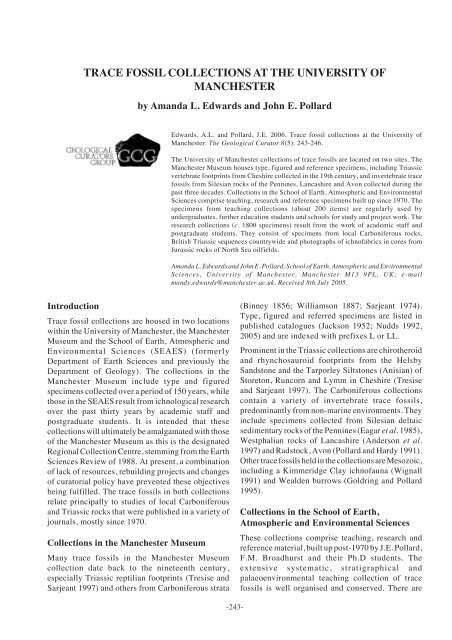Continental trace fossils and museum exhibits - Geological Curators ...
Continental trace fossils and museum exhibits - Geological Curators ...
Continental trace fossils and museum exhibits - Geological Curators ...
You also want an ePaper? Increase the reach of your titles
YUMPU automatically turns print PDFs into web optimized ePapers that Google loves.
TRACE FOSSIL COLLECTIONS AT THE UNIVERSITY OFMANCHESTERby Am<strong>and</strong>a L. Edwards <strong>and</strong> John E. PollardEdwards, A.L. <strong>and</strong> Pollard, J.E. 2006. Trace fossil collections at the University ofManchester. The <strong>Geological</strong> Curator 8(5): 243-246.The University of Manchester collections of <strong>trace</strong> <strong>fossils</strong> are located on two sites. TheManchester Museum houses type, figured <strong>and</strong> reference specimens, including Triassicvertebrate footprints from Cheshire collected in the 19th century, <strong>and</strong> invertebrate <strong>trace</strong><strong>fossils</strong> from Silesian rocks of the Pennines, Lancashire <strong>and</strong> Avon collected during thepast three decades. Collections in the School of Earth, Atmospheric <strong>and</strong> EnvironmentalSciences comprise teaching, research <strong>and</strong> reference specimens built up since 1970. Thespecimens from teaching collections (about 200 items) are regularly used byundergraduates, further education students <strong>and</strong> schools for study <strong>and</strong> project work. Theresearch collections (c. 1800 specimens) result from the work of academic staff <strong>and</strong>postgraduate students. They consist of specimens from local Carboniferous rocks,British Triassic sequences countrywide <strong>and</strong> photographs of ichnofabrics in cores fromJurassic rocks of North Sea oilfields.Am<strong>and</strong>a L. Edwards <strong>and</strong> John E. Pollard, School of Earth, Atmospheric <strong>and</strong> EnvironmentalSciences, University of Manchester, Manchester M13 9PL, UK; e-mailm<strong>and</strong>y.edwards@manchester.ac.uk. Received 8th July 2005.IntroductionTrace fossil collections are housed in two locationswithin the University of Manchester, the ManchesterMuseum <strong>and</strong> the School of Earth, Atmospheric <strong>and</strong>Environmental Sciences (SEAES) (formerlyDepartment of Earth Sciences <strong>and</strong> previously theDepartment of Geology). The collections in theManchester Museum include type <strong>and</strong> figuredspecimens collected over a period of 150 years, whilethose in the SEAES result from ichnological researchover the past thirty years by academic staff <strong>and</strong>postgraduate students. It is intended that thesecollections will ultimately be amalgamated with thoseof the Manchester Museum as this is the designatedRegional Collection Centre, stemming from the EarthSciences Review of 1988. At present, a combinationof lack of resources, rebuilding projects <strong>and</strong> changesof curatorial policy have prevented these objectivesbeing fulfilled. The <strong>trace</strong> <strong>fossils</strong> in both collectionsrelate principally to studies of local Carboniferous<strong>and</strong> Triassic rocks that were published in a variety ofjournals, mostly since 1970.Collections in the Manchester MuseumMany <strong>trace</strong> <strong>fossils</strong> in the Manchester Museumcollection date back to the nineteenth century,especially Triassic reptilian footprints (Tresise <strong>and</strong>Sarjeant 1997) <strong>and</strong> others from Carboniferous strata(Binney 1856; Williamson 1887; Sarjeant 1974).Type, figured <strong>and</strong> referred specimens are listed inpublished catalogues (Jackson 1952; Nudds 1992,2005) <strong>and</strong> are indexed with prefixes L or LL.Prominent in the Triassic collections are chirotheroid<strong>and</strong> rhynchosauroid footprints from the HelsbyS<strong>and</strong>stone <strong>and</strong> the Tarporley Siltstones (Anisian) ofStoreton, Runcorn <strong>and</strong> Lymm in Cheshire (Tresise<strong>and</strong> Sarjeant 1997). The Carboniferous collectionscontain a variety of invertebrate <strong>trace</strong> <strong>fossils</strong>,predominantly from non-marine environments. Theyinclude specimens collected from Silesian deltaicsedimentary rocks of the Pennines (Eagar et al. 1985),Westphalian rocks of Lancashire (Anderson et al.1997) <strong>and</strong> Radstock, Avon (Pollard <strong>and</strong> Hardy 1991).Other <strong>trace</strong> <strong>fossils</strong> held in the collections are Mesozoic,including a Kimmeridge Clay ichnofauna (Wignall1991) <strong>and</strong> Wealden burrows (Goldring <strong>and</strong> Pollard1995).Collections in the School of Earth,Atmospheric <strong>and</strong> Environmental SciencesThese collections comprise teaching, research <strong>and</strong>reference material, built up post-1970 by J.E. Pollard,F.M. Broadhurst <strong>and</strong> their Ph.D students. Theextensive systematic, stratigraphical <strong>and</strong>palaeoenvironmental teaching collection of <strong>trace</strong><strong>fossils</strong> is well organised <strong>and</strong> conserved. There are-243-
















